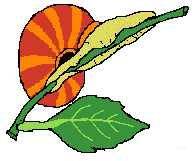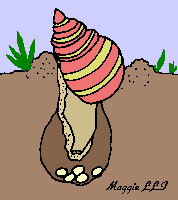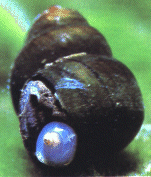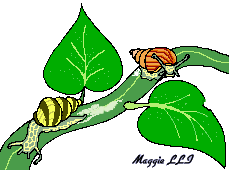All About Snails
Snail Facts and Resources For Teachers and Kids
| Snails | HOMEPAGE | Teacher's Corner |
| Kid's Corner | Holidays & Celebrations | Other Themes |
Garden Snails
Characteristics of Snails
Snails can be found in gardens, in ponds and even in the sea. They belong to a group of animals with a soft body called molluscs (mollusks) which are related to oysters, clams, and other shellfish. Characteristically they have soft, unsegmented bodies. Normally, their soft bodies are protected by a hard shell. The scientific name for the garden snail is Helix aspersa. It is a gastropod which in latin means, gastro for stomach and pod for foot or just "a belly footed animal". The body of the snail is long, moist and slimy. It has a shell to protect its soft body. When the snail is disturbed, it simply withdraws or pulls itself back into its shell. The snail also retreats into its shell and seals the entrance in dry weather to protect its body from drying up. A snail is most active at night and on cloudy days. It does not like the sunshine very much. During very cold weather or winter, it hibernates in the ground.
Snails have different shaped shells. It can be a single shell that is rounded, spiral high and pointed or it can be flat.
Some people keep snails in aquariums together with their fish. However, they must make sure that they control the number because snails reproduce rapidly !!
Snails do not like hot and dry conditions. They like it moist or humid and not too bright. You can collect some snails and put them into a transparent container. Put some leaves in it, keep it moist and you can observe and see how a snail moves and also its mouth part.
Snails can live up to 5 to 10 years. Some have been known to live up to 15 years.
Do you know where the snail's eyes are?
 Yes, the eye is on the tip of the tentacle or at the base of the tentacle for marine
species.
The snail has two pairs of
tentacles on its head. One pair is longer than the other pair. The eyes are
on the longer pair. The shorter pair is used for smelling and feeling its way around.
The tentacles are very important to the snail.
Yes, the eye is on the tip of the tentacle or at the base of the tentacle for marine
species.
The snail has two pairs of
tentacles on its head. One pair is longer than the other pair. The eyes are
on the longer pair. The shorter pair is used for smelling and feeling its way around.
The tentacles are very important to the snail.
What and how does a snail eat?
A snail have something called a radula in its mouth for grinding up its food. This radula is like a rough tongue, something like a file with rows of tiny teeth which it uses to scrap off leaves and flowers to eat. Many people get upset and farmers get angry when snails eat their plants and crops. Snails can cause serious damage to crops. Snails eat mostly living plants as well as decaying plants. They also chew on fruits and young succulent plant barks.
How big can the snail grow?
The largest known land snail named Gee Geronimo was a Giant African Snail collected in Sierra Leone in 1976. It weighed about 2lb (900g) and measured over 15 inches (39.3cm) from snout to tail.

The snail moves by creeping on a flat "foot" underneath the body. The band of muscles in the foot contract and expand and this create a kind of rippling movement that pushes the snail forward. The "foot" has a special gland that produces a slimy mucus to make a slippery track. You can often see these silvery tracks in the garden. The slime comes out from the front and hardens when it comes into contact with air. The snail is able to move on very sharp pointed needles, knife, razors and vines without being injured because the mucus-like secretion helps to protect its body.
Look at how the snail wraps its soft body around the branch so that it will not fall off.
The snail is both male and female. Therefore, it can produce sperms and eggs at the same time ! Isn't that incredible ? However, to fertilize the eggs, the snails need to exchange sperms with each other. An animal which is both a male and a female is called a hermaphrodite. The brown garden snail lays about 80 spherical shaped white or yellowish colored eggs at a time into the topsoil of the ground. It can lay eggs up to six times a year. Snails take about 2 years to become adults.
Life History of the snail
 Snails spend many hours courting before they mate. They twist themselves around each other and
cover themselves in frothy slime.
After mating, each snail will go search for a soft ground to dig and lay its eggs.
The snail lay its eggs in a nest, 2.5 to 4 cm deep in the soil. Each snail can lay an
average of 85 eggs and they hatch in 2 to 4 weeks, depending on the temperature
and moisture of the soil. The eggs are concealed with a mixture of soil and
mucus. They are then covered with excrement. Low temperatures of less than 12C and low
humidity inhibits laying eggs. Snails lay eggs most often during the warm and damp weather.
It can be as often as once a month or every 6 weeks. Their most active months are from February
to October.
Snails spend many hours courting before they mate. They twist themselves around each other and
cover themselves in frothy slime.
After mating, each snail will go search for a soft ground to dig and lay its eggs.
The snail lay its eggs in a nest, 2.5 to 4 cm deep in the soil. Each snail can lay an
average of 85 eggs and they hatch in 2 to 4 weeks, depending on the temperature
and moisture of the soil. The eggs are concealed with a mixture of soil and
mucus. They are then covered with excrement. Low temperatures of less than 12C and low
humidity inhibits laying eggs. Snails lay eggs most often during the warm and damp weather.
It can be as often as once a month or every 6 weeks. Their most active months are from February
to October.
The first thing that a newly hatched snail does is to find food. It will eat whatever that is left of its eggshell too. It will also eat any eggs that have not hatched yet. As the snail grows, its shell grows too in a spiral shape. The new shell is added at the opening of the shell. The part of the shell the baby snail was born with, ends up in the middle of the spiral.
The snails have enemies too
Snails have many natural enemies. They are the ground beetles, snakes, toads, turtles, and birds including chickens, ducks and geese.
POND SNAILS
It is fun to play in the country. If you come across a pond in the country, you will find animals like fish, prawns, insects and the pond snail. The pond snail is, in many ways like the garden snail. Pond snails are usually tan or dark brown in color.
How do they breathe in water?
Some pond snails have gills to breathe in water. Those with gills will live at the bottom of the pond. Those that do not have gills, will come up to the surface to breathe. These snails will live on the surface so that they can come up to breathe easily.
Do you know that pond snails can be eaten?
You can buy pond snails from a fish monger in the city. The flesh of the snail is very delicious. The French people especially, love to eat snails. One important thing to remember here is to make sure that you clean and rinse the pond snails with plenty of clean water to wash away the dirt and mud.
What does the pond snail feed on?
The pond snail feeds mainly on plants like algae and microscopic creatures that are found on the surface of water weeds. They eat by scraping bits off with their rough tongue just like the garden snails.

How does the pond snail reproduce?
The pond snail reproduces just like the garden snail. It is a hermaphrodite. The only difference is that, unlike the garden snail, the pond snail carries its fertilized eggs with it. The baby snail will only leave its mother when it is hatched.
How to collect pond snails?
First of all, you will need a spade, fishing net, a container (to put your snails in). Make sure your container is not air tight so that the snails can breathe. You can do this by making tiny holes on the lid. You need a lid to cover your container because snails can crawl on any texture or surface. Choose a damp spot near the pond and then use your spade to loosen the ground and you will find many snails just beneath the surface.
DISCLAIMER : This is a disclaimer. We try to gather information that are
as accurate as possible. However, if there are mistakes, we will not be held
liable for anything. Use it at your own discretion.
IMPORTANT : We are not responsible for any links beyond our site.



